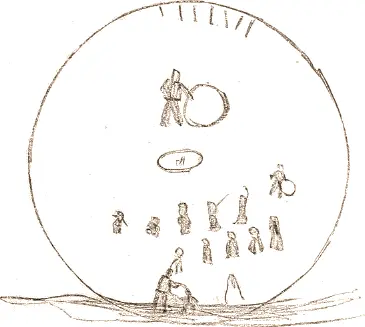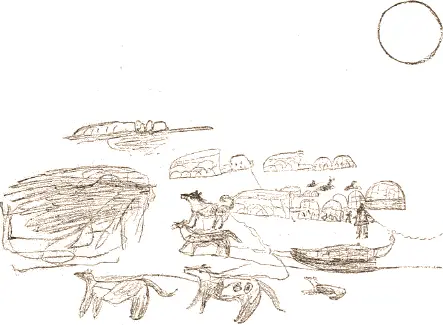At last the elder brothers, being tired of roaming about, returned home. When they heard that the boy had been badly used by all the Inuit they became angry and thought of revenge. At first, however, they did not say anything, but built a boat, in which they intended to escape after having accomplished their designs. They were skillful boat builders and finished their work very soon. They tried the boat and found that it passed over the water as swiftly as an eider duck flies. As they were not content with their work they destroyed it again and built a new boat, which proved as swift as an ice duck. They were not yet content, destroyed this, and built a third one that was good. After having finished the boat they lived quietly with the other men. In the village there was a large singing house, which was used at every festival. One day the three brothers entered it and shut it up. Then they began dancing and singing and continued until they were exhausted. As there was no seat in the house they asked their mother to bring one, and when they opened the door to let her pass in, an ermine, which had been hidden in the house, escaped.
Near the singing house the other Inuit of the village were playing. When they saw the ermine, which ran right through the crowd, they endeavored to catch it. In the eagerness of pursuit one man, who had almost caught the little animal, stumbled over a bowlder and fell in such a manner that he was instantly killed. The ermine was sprinkled with blood, particularly about its mouth. During the ensuing confusion it escaped into the singing house, where it concealed itself again in the same corner.
The brothers, who were inside, had recommenced singing and dancing. When they were exhausted they called for their mother (to bring something to eat). When they opened the door the ermine again escaped and ran about among the Inuit, who were still playing outside.
When they saw it they believed that the brothers would induce them to pursue it again, and thus make them perish one by one. Therefore the whole crowd stormed the singing house with the intention of killing the brothers. As the door was shut they climbed on the roof and pulled it down, but when they took up their spears to pierce the three men they opened the door and rushed down to the beach. Their boat was quite near at hand and ready to be launched, while those of the other Inuit were a long distance off.
They embarked with their mother, but, when they were at a short distance and saw that the other men had not yet reached their boats, they pretended that they were unable to move theirs, though they pulled with the utmost effort. In reality, they played with the oars on the water. A few young women and girls were on the shore looking at the brothers, who seemed to exert themselves to the utmost of their strength. The eldest brother cried to the women: “Will you help us? We cannot get along alone.” Two girls consented, but as soon as they had come into the boat the brothers commenced pulling as hard as possible, the boat flying along quicker than a duck, while the girls cried with fright. The other Inuit hastened up desirous to reach the fugitives, and soon their boats were manned.
The brothers were not afraid, however, as their boat was by far the swiftest. When they had almost lost sight of the pursuers they were suddenly stopped by a high, bold land rising before the boat and shutting up their way. They were quite puzzled, as they had to retrace their way for a long distance and feared they would be overtaken by the other boats. But one of the brothers, who was a great angakoq, saved them by his art. He said: “Shut your eyes and do not open them before I tell you, and then pull on.” They did as they were bade, and when he told them to look up they saw that they had sailed right through the land, which rose just as high and formidable behind them as it had formerly obstructed their way. It had opened and let them pass.
After having sailed some time they saw a long black line in the sea. On coming nearer they discovered that it was an impenetrable mass of seaweed, so compact that they could leave the boat and stand upon it. There was no chance of pushing the boat through, though it was swifter than a duck. The eldest brother, however, thought of his angakoq art and said to his mother, “Take your hair lace and whip the seaweed.” As soon as she did so it sank and opened the way.
After having overcome these obstacles they were troubled no more and accomplished their journey in safety. When they arrived in their country they went ashore and erected a hut. The two women whom they had taken from their enemies they gave to their young brother Qaudjaqdjuq.
They wanted to make him a very strong man, such as they were themselves. For this reason they led him to a huge stone and said, “Try to lift that stone.” As Qaudjaqdjuq was unable to do so, they whipped him and said, “Try it again.” Now Qaudjaqdjuq could move it a little from its place. The brothers were not yet content and whipped him once more. By the last whipping he became very strong and lifted the bowlder and cast it over the hut.
Then the brothers gave him the whip and told him to beat his wives if they disobeyed him.
Table of Contents
A long time ago there was a poor little orphan boy who had no protector and was maltreated by all the inhabitants of the village. He was not even allowed to sleep in the hut, but lay outside in the cold passage among the dogs, who were his pillows and his quilt. Neither did they give him any meat, but flung old, tough walrus hide at him, which he was compelled to eat without a knife. A young girl was the only one who pitied him. She gave him a very small piece of iron for a knife, but bade him conceal it well or the men would take it from him. He did so, putting it into his urethra. Thus he led a miserable life and did not grow at all, but remained poor little Qaudjaqdjuq. He did not even dare to join the plays of the other children, as they also maltreated and abused him on account of his weakness.

Fig. 537. Qaudjaqdjuq is maltreated by his enemies. Drawn by Qeqertuqdjuaq, an Oqomio.
When the inhabitants assembled in the singing house Qaudjaqdjuq used to lie in the passage and peep over the threshold. Now and then a man would lift him by the nostrils into the hut and give him the large urine vessel to carry out (Fig. 537). It was so large and heavy that he was obliged to take hold of it with both hands and his teeth. As he was frequently lifted by the nostrils they grew to be very large, though he remained small and weak.

Fig. 538. The man in the moon comes down to help Qaudjaqdjuq.
At last the man in the moon, 11who had seen how badly the men behaved towards Qaudjaqdjuq, came down to help him. He harnessed his dog 12(Fig. 538) Tirie´tiang to his sledge and drove down. When near the hut he stopped and cried, “Qaudjaqdjuq, come out.” Qaudjaqdjuq answered, “I will not come out. Go away!” But when he had asked him a second and a third time to come out, he complied, though he was very much frightened. Then the man in the moon went with him to a place where some large bowlders were lying about and, having whipped him (Fig. 539), asked, “Do you feel stronger now?” Qaudjaqdjuq answered: “Yes, I feel stronger.” “Then lift yon bowlder,” said he. As Qaudjaqdjuq was not yet able to lift it, he gave him another whipping, and now all of a sudden he began to grow, the feet first becoming of an extraordinary size (Fig. 540). Again the man in the moon asked him: “Do you feel stronger now?” Qaudjaqdjuq answered: “Yes, I feel stronger;” but as he could not yet lift the stone he was whipped once more, after which he had attained a very great strength and lifted the bowlder as if it were a small pebble. The man in the moon said: “That will do. To-morrow morning I shall send three bears; then you may show your strength.”
Читать дальше














